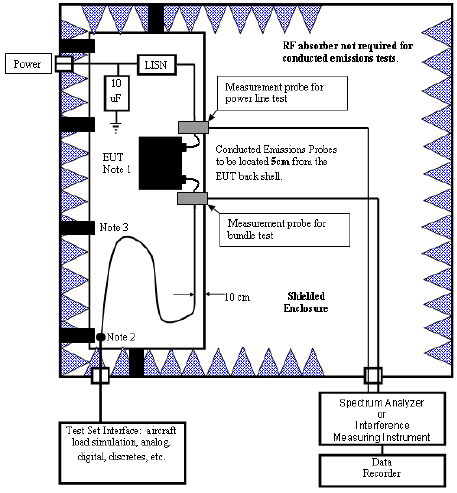- Rentals
- SERVICES
- EMC Applications
- Manufacturers
- Request A Quote
- Specials & Promotions
- Sell Your Equipment
- About us

- Home /
- EMC Applications /
- RTCA/DO-160 /
- RTCA/DO-160 Section 21
RTCA/DO-160 Section 21
RTCA DO-160 Section 21 focuses on the emission of radio frequency (RF) energy. The purpose of this testing is to determine that the equipment under test (EUT) does not emit RF noise levels that exceed the specified limits. During testing, the power leads and interconnecting cables are measured after being exposed to conducted RF emissions and for radiated RF emissions it may be emitting.
In order to make these measurements, an instrument with a peak detector, IF bandwidths, frequency step size, and dwell time must be used.

For conducted emissions testing, clamp-on current probes are used to measure the conducted RF current on the interconnecting cables and power leads. The EUT is required to be five centimeters away from the current probe. Measurements are taken within the frequency range of 150 kHz to 150 MHz.
There are two types of tests when testing for radiated emissions under DO-160 Section 21. The first type is completed using an Anechoic Chamber lined with an RF absorber. The second test is completed using a Reverberation Chamber. Both tests require a linearly polarized antenna to measure radiated RF fields within the frequency range of 100 MHz to 6 GHz.
The location of the equipment and required separation between the equipment and aircraft antennas is determined through six different equipment categories (B, L, M, H, P, Q). As a rule of thumb, the allowable emissions limits become narrower the closer the equipment is to the antenna.
Contact us to speak to a representative that can help set you up with the necessary equipment to satisfy the requirements defined in DO-160 Section 21. Rent from Avalon and Test With Confidence®.
Read More
Read Less
- SAN DIEGO | HQ
3194 Lionshead Avenue
Carlsbad, CA 92010 - DALLAS
2928 Skyway Circle North
Irving, TX 75038
- info@avalontest.com
- 760.536.0191
Stay up to date on all things Avalon! Be the first to hear about our latest offers and discounts!

